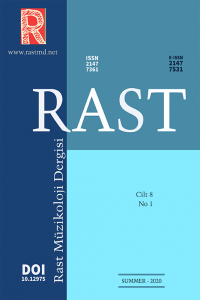Abstract
References
- Behar, C. (2005). Musikiden müziğe. İstanbul: YKY.
- Behar, C. (2017). Şeyhülislam’ın Müziği. İstanbul: YKY.
- Ezgi, S. (1933). Ameli ve Nazari Türk Musikisi (Cilt 3). İstanbul: İstanbul Konservatuarı Neşriyatı.
- Hargreaves, D. J., & North, A. C. (1997). The social psychology of music. Oxford: Oxford University Pres.
- İrden, S. (2020). Türk Musikisinde Düzen Perde Makam Terkib Uygulamaları. Konya: Eğitim Yayınevi.
- Kuşoğlu, O. (2009). Mir Muhsin Nevvab’ın Vuzûhu’l Erkam Adlı Risalesi ve Şerhleri. İstanbul: İSAR.
- Kutluğ, Y. F. (2000). Türk Musikisinde Makamlar - İnceleme (Cilt I). İstanbul: YKY.
- Seferova, Z. (2006). Azerbaycan Musiki İlmi; XIII-XX Asırlar. Bakü: Azerneşr.
- Soysal, F. (2012). Rast Muğamı Çerçevesinde Azerbaycan Muğam Kavramı. Diyarbakır: Fikri Soysal Yayınları.
- Storey, J. (2000). Popüler Kültür Çalışmaları Kuramlar ve Metotlar. (K. Karaşahin, Çev.) İstanbul: Babil.
- Weitz, M. (1956). The Role of Theory in Aesthetics . The Journal of Aesthetics and Art Criticism, 15(1), 27-35. doi:10.2307/427491
Abstract
Music has different functions, such as being a communication tool, in human life. It may sometimes apply to people who have the same culture and language, and it may also apply to people who are from different cultures or who speak different languages. Folk music and art music are also communication tools of Turkish society. Folk music is considered as rural music, and art music is considered as urban music, and they are generalized to the population. However, a study should represent the population so that it can be generalized to the population. There are no adequate studies on folk music. Moreover, it is considered that acting as if Turkish music consists of Anatolia does not produce accurate results. In this study, it will be revealed that Turkish folk music has an artistic structure through the example of the Azerbaijani mugham form. The mugham form is a systematic musical form. The succession of sections is not accidental. On the contrary, each section occurs in a certain musical function relationship.
Keywords
References
- Behar, C. (2005). Musikiden müziğe. İstanbul: YKY.
- Behar, C. (2017). Şeyhülislam’ın Müziği. İstanbul: YKY.
- Ezgi, S. (1933). Ameli ve Nazari Türk Musikisi (Cilt 3). İstanbul: İstanbul Konservatuarı Neşriyatı.
- Hargreaves, D. J., & North, A. C. (1997). The social psychology of music. Oxford: Oxford University Pres.
- İrden, S. (2020). Türk Musikisinde Düzen Perde Makam Terkib Uygulamaları. Konya: Eğitim Yayınevi.
- Kuşoğlu, O. (2009). Mir Muhsin Nevvab’ın Vuzûhu’l Erkam Adlı Risalesi ve Şerhleri. İstanbul: İSAR.
- Kutluğ, Y. F. (2000). Türk Musikisinde Makamlar - İnceleme (Cilt I). İstanbul: YKY.
- Seferova, Z. (2006). Azerbaycan Musiki İlmi; XIII-XX Asırlar. Bakü: Azerneşr.
- Soysal, F. (2012). Rast Muğamı Çerçevesinde Azerbaycan Muğam Kavramı. Diyarbakır: Fikri Soysal Yayınları.
- Storey, J. (2000). Popüler Kültür Çalışmaları Kuramlar ve Metotlar. (K. Karaşahin, Çev.) İstanbul: Babil.
- Weitz, M. (1956). The Role of Theory in Aesthetics . The Journal of Aesthetics and Art Criticism, 15(1), 27-35. doi:10.2307/427491
Details
| Primary Language | English |
|---|---|
| Journal Section | Original research |
| Authors | |
| Publication Date | July 23, 2020 |
| Published in Issue | Year 2020 Volume: 8 Issue: 1 |
Our authors are required to respond to editorial emails within 3 days to avoid any disruption to the editorial process.


